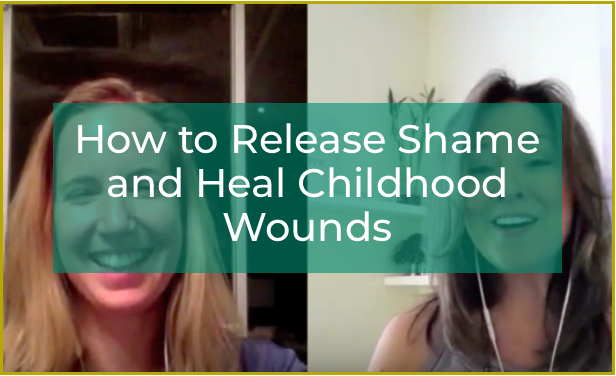How to Release Shame and Heal Childhood Wounds

“Cover your shame!” Someone said this to my three year old son a year ago when he was running around a family member’s kitchen pant-less between changes of clothes.
The only thing sadder than living in a world where people still refer to a penis as someone’s “shame” is living in a world where we all go around with the soundtrack of “cover your shame” running through our minds.
Because that’s what we do when we feel shame – our instinct is to take cover and hide parts of ourselves. This influences our sense of self-worth and our ability to connect with others since we are afraid to be fully seen and to be fully us, au naturel.
We all begin experiencing shame in our childhood, with triggers ranging from something as serious as sexual abuse to a one sentence comment made in passing about our body that makes us feel like we’re flawed in some way.
As we age, the layers of shame keep piling up unless we release shame and heal our wounds – choosing to be seen over choosing to hide.
To deepen my understanding of shame and how it affects us I reached out to Peggy Oliveira, a transformational healing mentor and speaker with over 15 years experience as a psychotherapist and advocate.
Known as the Survivor Whisperer, Peggy shares her expertise as a trauma therapist and her personal experience of childhood abuse to help heal the shame of sexual abuse and assault, and all faces of shame by spreading the broader message that it’s #notourshame.
She is the founder of Courageous Journeys and her deepest desire is to help women uncover their hidden wounds and heal their shame, allowing them to finally find the freedom they deserve.
In this interview Peggy shares:
- Why every child is affected by negative experiences and the common thing adults do that makes it worse (9:55)
- Red flags that indicate there’s healing to be done in your own life (11:38)
- Why motherhood and shame are intricately linked (17:25), what to do about it as a parent (22:20), and how to reduce the long term impact of negative experiences on your child (26:30)
- How to recognize when shame is holding you back and how to release it (32:18)
- The one perspective shift that will transform your experience of shame forever (43:20)
Click below to watch:
During this interview I also share two personal stories that most parents would cringe to admit to in public… let’s feel awkward and release the shame together.
Releasing shame allows us to access more confidence, freedom, and fulfilment, as well as puts us in a better position to prevent perpetuating patterns of shame in our lives and in our families and communities.
Next time you feel shame, I invite you to join me in vibrating the mantra Peggy shares with us:

![]()
Invitation: Begin Releasing Your Shame
1. Uncover | Take a few seconds to reflect on the following question: What is one experience in my life (or aspect of who I am) that I’m ashamed to let others know about?
2. Release | Reach out to someone you trust and start the process of owning this and releasing the shame by telling them about it. If you feel nervous reaching out to a friend, family member, or professional, start with a furry friend.
x Catarina

Trackbacks/Pingbacks